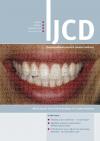International Journal of Cosmetic Dentistry

- Cover Date:
- September 2011
- Print ISSN:
- 1754-2766
- Vol:
- 2
- Issue:
- 1
Treating a discoloured tooth to match an otherwise unrestored dentition
Introduction and patient’s chief complaint
The patient was a 24-year-old dental nurse who had experienced trauma to her upper left central incisor as a teenager and which had been endodontically treated and restored with a large MI composite. There was discolouration evident in the remaining tooth structure and the patient was becoming increasingly self-conscious of her smile. had some posterior restorations present, good oral hygiene and good periodontal condition. The patient’s occlusion was symptomless; she was able to chew comfortably and there was no muscle tenderness on palpation. There was no evidence of parafunction and there appeared to be good disclusion posteriorly on excursions with no non-working interferences and canine guidance bilaterally. There were no signs of occlusal instability and the TMJ was assumed to be healthy. reviewed by Dundee Dental Hospital and deemed a healing area which was safe to restore. A full coronal seal was recommended. The patient was also having treatment at the dental hospital for tooth 26, which has undergone further treatment and was scheduled for a full coverage restoration once the Dental Hospital had discharged her. Tooth 21 was also positioned lingual to 11, which the patient requested to be corrected. She also noted that she had previously had a slight space between her central incisors which was corrected with the restoration of 21 and she was keen to maintain the same appearance with the new restoration. In reality, this presented a challenge in keeping the facial widths of both centrals the same, even though the actual width of both varied by 0.2mm.
- Article Price
- £15.00
- Institution Article Price
- £
- Page Start
- 16
- Page End
- 18
- Authors
- Elaine Halley
Articles from this issue
- Title
- Pg. Start
- Pg. End
